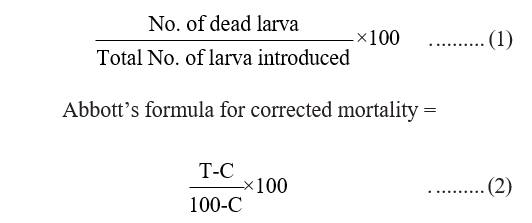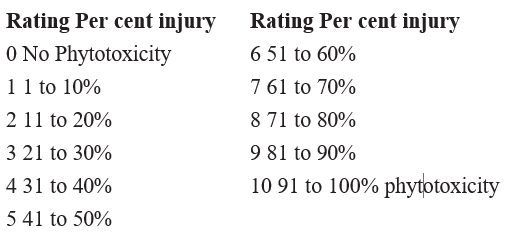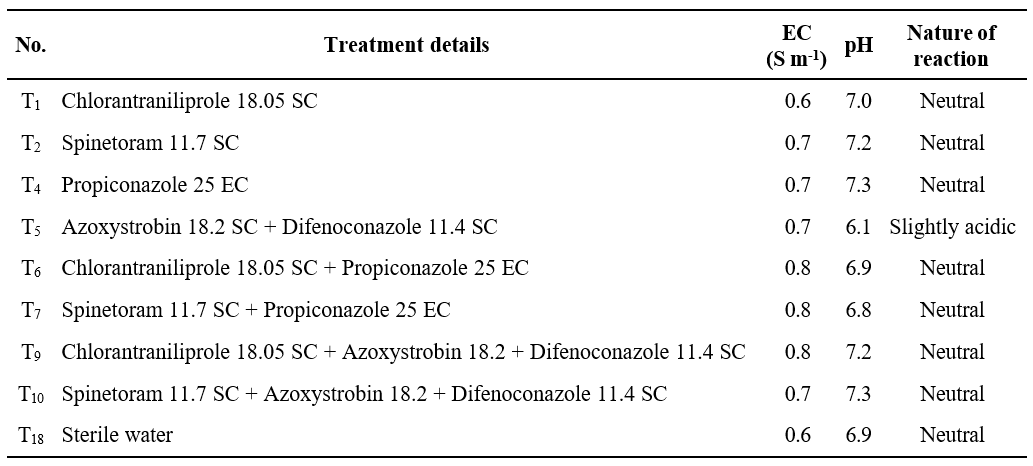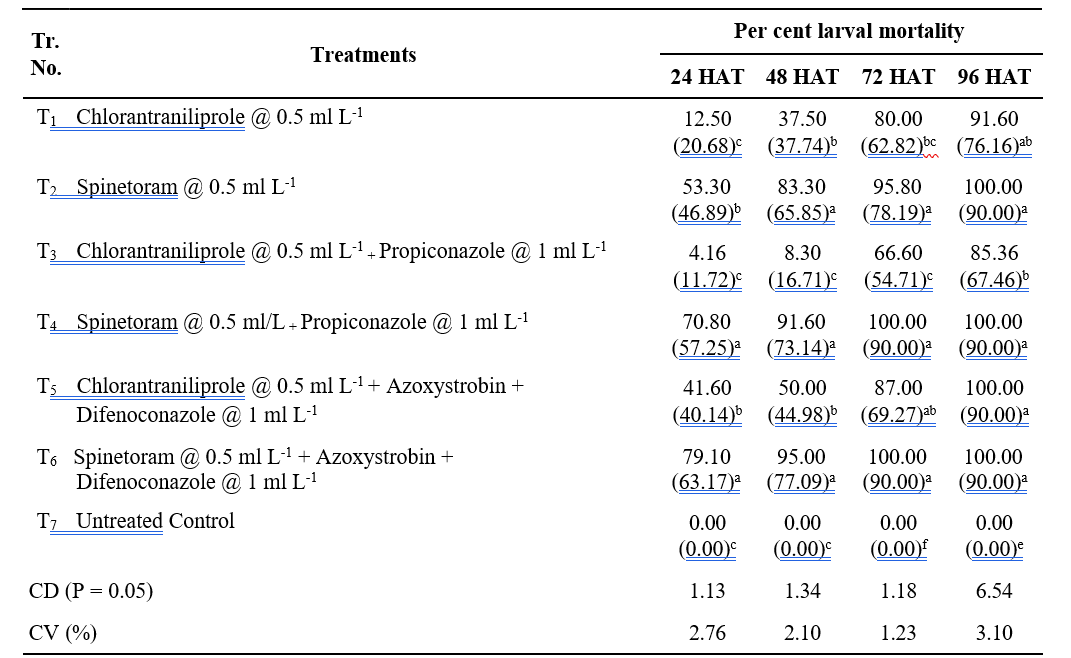Physical Compatibility of Insecticide + Fungicide Combinations And Their Bio Efficacy Against Fall Armyworm, Spodoptera Frugiperda
0 Views
RESHMA P, RAJASRI MANDALI, M.K. JYOSTHNA AND J. MANJUNATH
Department of Entomology, S.V. Agricultural College, ANGRAU, Tirupati-517 502.
ABSTRACT
An experiment on physical, biological and phytotoxic compatibility of different combinations of two insecticides (chlorantraniliprole @ 0.5 ml L-1 and spinetoram @ 0.5 ml L-1), fungicides (propiconazole @ 1 ml L-1 and azoxystrobin + difenoconazole @ 1 ml L-1) and Bacillus thuringiensis @ 10 ml L-1 were conducted in laboratory, at S. V. Agricultural College, Tirupati, Andhra Pradesh in 2023. All the combinations tested were found to be physically compatible with pH levels ranged from 6.1 to 7.3. The in vitro bio efficacy studies revealed that all the combinations of spinetoram with azoxystrobin + difenoconazole and propiconazole were much effective with cent per cent of larval mortality, than spinetoram alone at 72 HAT. Only one combination, chlorantraniliprole + propiconazole was found to be less effective than the individual insecticide. No phytotoxic symptoms were observed with any of the combinations.
KEYWORDS: Bio efficacy, Maize, Physical compatibility, Phytotoxicity, Spodoptera frugiperda
INTRODUCTION
Maize (Zea mays L.), ‘queen of cereals’ holds significant importance in India, ranking third after rice and wheat. India is the sixth largest producer of maize with 324.70 lakh tonne tonnes production and 3260 kg/ha productivity (www.indiastat.com) in 2023- 24. The insect pests and diseases plays a major role in the reduction of production of maize. Fall armyworm (FAW), Spodoptera frugiperda (J.E. Smith) (Lepidoptera: Noctuidae) is an invesive pest poses a serious threat to the maize crop system which was first reported at Karnataka (Sharanabasappa et al., 2018). Fall armyworm can cause yield losses from 8.3 to 20.6 million tonnes per annum i.e., 21-53 percent of production, if left unmanaged (Abrahams et al., 2017). Major diseases occurring in maize during rabi are turcicum leaf blight (Exserohilum turcicum), banded leaf and sheath blight (Rhizoctonia solani), charcoal-rot (Macrophamina phaseolina), common rust (Puccinia sorghi). The simultaneous occurrence of pests and diseases challenges farmers, leading them to use mixed pesticides to cut costs. While some pesticides are safe alone, they can be harmful in combination. These interactions must be classified as antagonistic, additive, or synergistic (Gandini et al., 2020). The simultaneous occurrence of both pests and diseases became a significant challenge for the farmers. Interactions between different pesticides have to be analyzed and classified as being either antagonistic, additive or synergistic (Gandini et al., 2020). However, these combinations can cause physical incompatibility, reduce bio efficacy, induce phytotoxic effects, or lead to insecticide resistance in pests (Peshney, 1990; Miller et al., 2010). Hence, it is crucial to assess the compatibility and bio efficacy of various agrochemicals before tank mixing them for simultaneous use in pest and disease management in the field.
MATERIAL AND METHODS
The experiment on physical, biological and phytotoxic compatibility of different combinations of two insecticides (chlorantraniliprole @ 0.5 ml L-1 and spinetoram @ 0.5 ml L-1), fungicides ( propiconazole @ 1 ml L-1 and azoxystrobin + difenoconazole @ 1 ml L-1) were conducted in laboratory and wetland farm of S. V. Agricultural College, Tirupati, Andhra Pradesh during 2023-24.
Physical compatibility
The physical compatibility of insecticides and fungicides was tested using a jar test. In a one liter glass jar, 500 ml of distilled water was mixed with the insecticide and fungicide at their recommended doses. The mixture was adjusted to 1 liter with distilled water, thoroughly agitated, and left undisturbed. Foaming and sedimentation were observed at 30 and 60 minutes after preparation. pH and EC of individual pesticides and combinations were recorded using digital pH meter and electrical conductivity meter according to Bickelhaupt and Donald (2012) as follows:

Bio efficacy test against FAW, S. frugiperda
For the bio efficacy test against fall armyworm (FAW), Spodoptera frugiperda, third instar larvae with uniform size were selected. The artificial diet incorporation method was used for bio assay. A 30 μl stock solution of the pesticide mixture was applied to the artificial diet and allowed to dry. Third instar larvae, of uniform size, were deprived of food for 3 hours before being placed in containers with the treated diet. Each treatment was replicated three times with eight larvae per treatment, including a control diet without pesticides. Mortality was recorded at 24, 48, and 72 hours after treatment.
Mortality per cent was assessed and corrected by the equation (1) and the mortality data was corrected by using modified Abbotts formula (Abbott, 1925) (2) where ever the >10 per cent mortality recorded in the control.
Per cent larval mortality =

where, T = Mortality in treatment
C = Mortality in control
Phytotoxicity test
The phytotoxicity experiment assessed the effects of insecticide and fungicide combinations by spraying maize plants with insecticide + fungicide combinations at twice the recommended concentration. Observations of phytotoxic symptoms such as chlorotic leaf margins, reddish or purplish veins, wrinkled leaves, stunted growth, necrosis, wilting, and whiplashing were recorded one day before spraying and at 3, 5, 7, and 10 days after spraying, using the phytotoxicity scale provided by CIB&RC.
Leaf injury assessment by visual ratings in 0 to 10 scale

RESULTS AND DISCUSSIONS
Physical compatibility
Among different combinations tested all were physically compatible without any sedimentation and foaming. The pH levels of the tested combinations ranged from 6.1 to 7.3, covering a spectrum from slightly alkaline to slightly acidic, which is considered safe for plants. The individual pesticides viz., chlorantraniliprole 18.05 SC, spinetoram 11.7 SC, propiconazole 25 EC and azoxystrobin 18.2 + difenoconazole 11.4 SC were reported with pH levels of 7.0, 7.2, 6.0 and 7.3 respectively, that indicates these are included in the pH range which is not harmful to the plants. The pH of combinations of chlorantraniliprole 18.05 SC with fungicides, propiconazole 25 EC and azoxystrobin 18.2 + difenoconazole 11.4 SC are also neutral with pH of 6.9 and 7.2. The pH combinations of of spinetoram 11.7 SC with fungicides propiconazole 25 EC and azoxystrobin 18.2 + difenoconazole 11.4 SC were 6.8 and 7.3 which indicates both are neutral in nature (Table 1).
Similar results were also witnessed by Visalakshmi et al. (2016) who concluded that chlorantraniliprole 18.5 SC, chlorpyriphos 20 EC, cartap hydrochloride 50SP, flubendiamide 480 SC, profenophos 50 EC in combination with trifloxystrobin 25 + tebuconazole 50 WG, propiconazole 25 ECwere physically compatible. Anil et al. (2024) reported that insecticide chlorantraniliprole and propiconazole are physically compatible. Sandhya et al. (2021) also supports the results, chlorantraniliprole and azoxystrobin + difenoconazole are compatible each
Table 1. pH and EC of insecticide solutions and their combinations with fungicides and bio pesticide

Table 2. Efficacy of insecticide + fungicide combinations against third instar larvae of fall armyworm, S. frugiperda under laboratory condition

Table 3. Phytotoxicity effects of insecticide + fungicide combinations on maize leaves at double the recommended doses

other. Matcha (2021) had also reported similar results.
Bio efficacy test against FAW, S. frugiperda
The results showed that combining spinetoram with fungicides like azoxystrobin + difenoconazole and propiconazole resulted in significantly higher larval mortality rates of 79.10 and 80.80, respectively, which were much higher than spinetoram alone (53.30 per cent). Chlorantraniliprole combined with azoxystrobin + difenoconazole achieved a mortality rate of 50.00 per cent, exceeding chlorantraniliprole alone (8.30 percent) at 24 hours after treatment. At 72 hours after treatment, spinetoram with azoxystrobin + difenoconazole and propiconazole resulted in 100 percent larval mortality, higher than spinetoram alone (95.80 percent) and chlorantraniliprole combined with azoxystrobin + difenoconazole showed an 87.00 percent mortality rate. The only combination showing less efficacy than the individual insecticide was chlorantraniliprole + propiconazole, with 85.36 percent larval mortality at 96 hours, compared to chlorantraniliprole alone (91.60 percent) and the combination with azoxystrobin + difenoconazole (100 percent) (Table 2).
Similar results were also reported by Thumar et al. (2020) where spinetoram was found to be most effective than emamectin benzoate, chlorantraniliprole and thiodicarb against fall armyworm, S. frugipera on maize. Similarly the efficacy of spinetoram on fall armyworm, frugiperda over chlorantraniliprole and emamectin benzoate was reported by Cheema et al. (2021). The effectiveness of spinetoram over chlorantraniliprole was also reported by many researchers earlier, Patidar et al. (2022) and Bhimani et al. (2024).
The efficacy of chlorantraniliprole on fall armyworm was also reported by many workers, Altaf et al. (2022) and Singh and Tayde (2024).
Siddartha and Revannavar (2014) reported that combinations of chlorantraniliprole (33.9%), flubendiamide, novaluron with fungicide Saaf® when compared to their individaual mortality with a highest mortality in case of chlorantraniliprole + Saaf® (100%) against diamond back moth, Plutella xylostella .
Phytotoxicity
None of the combinations had shown any kind of phytotoxicity symptoms like chlorotic leaf margins and laminas, reddish or purplish veins, wrinkled leaves, death of leaf tissue (necrosis), wilting, whiplashing, scorching and bleaching of foliage and reduced growth. The phytotoxicity scale recorded was zero.
Present findings were in accordance with earlier reports of Sabitha et al. (2020) who reported the insecticides, flonicamid 50 WG, chlorantraniliprole 18.5 SC and acephate 75 SP and fungicides, difenoconazole 25 EC and azoxystrobin 23 EC combinations on rice were compatible physically and biologically without any phytotoxic symptoms. Sandhya et al. (2021) who investigated physical compatibility of insecticides and fungicides viz., lambda cyhalothrin + chlorantraniliprole, chlorantraniliprole, flubendiamide, azadirachtin 1500 ppm and two fungicides azoxystrobin + difenoconazole, carbendazim + mancozeb in maize and found that all the 8 combinations without causing any phytotoxicity symptoms.
All the combinations of insecticide and fungicide were physically compatible without any issues of sedimentation or foaming. The pH values of these combinations ranged from 6.1 to 7.3, indicating a slightly acidic to slightly alkaline range, which suggests that all combinations are safe for plants. All the combinations were effective over individual insecticide except chlorantraniliprole + propiconazole. Spinetoram with fungicides, azoxystrobin + difenoconazole and propiconazole were most effective with cent per cent of larval mortality over spinetoram alone (95.80 %) at 72 HAT. None of the combinations were recorded with any phytotoxic symptoms on maize plant even at double the recommended dose.
LITERATURE CITED
Abbott, W.S. 1925. A method of computing the effectiveness of an insecticide. Journal of Economic Entomology, 18(2): 265-267.
Abrahams, P, Bateman, M, Beale, T, Clottey, V, Cock, M, Colmenarez, Y and Witt, A 2017 Fall armyworm: impacts and implications for Africa. Center for Agriculture and Bioscience International-CABI. 28: 5.
Altaf, N., Arshad, M., Majeed, M.Z., Ullah, M.I., Latif, H., Zeeshan, M., Yousuf, G and Afzal, M. 2022. Comparative effectiveness of chlorantraniliprole and neem leaf extract against fall armyworm, Spodoptera frugiperda (JE Smith) (Lepidoptera: Noctuidae). Sarhad Journal of Agriculture. 38(3): 833-840.
Anil, M., Hugar, S.V., Channakeshava, R and Huilgol, S.N. 2024. Compatibility studies on selective insecticides, fungicides and water-soluble fertilizer mixtures in soybean. Journal of Scientific Research and Reports. 30(4): 95-102.
Bhimani, A.M., Kachot, A.V., Patel, D.S and Jethva, D.M. 2024. Laboratory efficacy of different insecticides against maize fall armyworm, Spodoptera frugiperda (JE Smith). International Journal of Entomology Research. 8(3): 22-24.
Bickelhaupt and Donald 2012. Soil pH: what it means. E-Center Learning Resources. (http://esf.edu/ pubprog/brochure/soilph/soil ph.html.)
Cheema, H.K., Jindal, J., Aggarwal, N., Kumar, S and Sharma, U. 2021. Insecticidal management of Spodoptera frugiperda (JE Smith) on grain and fodder maize in Punjab. Pesticide Research Journal. 33(1): 72-77.
Gandini, E.M.M., Costa, E.S.P., dos Santos, J.B., Soares, M.A., Barroso, G.M., Correa, J.M., Carvalho, A.G and Zanuncio, J.C. 2020 Compatibility of pesticides and/or fertilizers in tank mixtures. Journal of Cleaner Production. 268: 122-152.
Matcha, N. 2021. Studies on chemical and non-chemical approaches for the management of Spodoptera species complex on soybean and castor and its safety to beneficial insects. M. Sc. Thesis
Miller, D.K., Downer, R.G and Stephenson, D.O. 2014. Interactive effects of tank- mixed application of insecticides, glyphosate and pendimethalin on growth and yield of second-generation glyphosate resistant cotton. The Journal of Cotton Science. 186-190.
Patidar, S., Das, S.B., Vishwakarma, R., Kumari, P., Mohanta, S and Paradkar, V.K. 2022. Field evaluation of insecticides against fall armyworm infesting maize. The pharma Innovation Journal. 11(4): 892-895.
Peshney, N.L. 1990. Compatibility of fungicides with some insecticides with reference to fungitoxicity and phytotoxicity. Punjabrao Krishi Vidyapeeth Research Journal. 14: 35-37.
Sabitha, C., Dhurua, S., Sreesandhya, N and Suresh, M. 2020. Physical compatibility and phytotoxic studies of insecticides and fungicide mixtures on rice. Andhra Pradesh Journal of Agricultural Science. 67(3): 187-193.
Sandhya, M., Vanisree, K., Upendhar, S and Mallaiah, B. 2021. Physical and phytotoxic compatibility of new generation insecticides and fungicides on maize. Pharma Innovation Journal. 10(8): 1855-1858.
Sharanabasappa, Kalleshwaraswamy, C.M., Asokan, R., Mahadeva Swamy, H.M., Maruthi, M.S., Pavithra, H.B., Kavita Hedge, Shivaray Navi, Prabhu, S.T and Goergen, G. 2018. First report of the fall armyworm, Spodoptera frugiperda (J E Smith) (Lepidoptera: Noctuidae), an alien invasive pest on maize in India. Pest Management in Horticultural Ecosystems. 24(1): 23-29.
Siddartha, D and Revanna Revannavar, S.D. 2014. Compatibility of selected insecticides with fungicide Saaf® against Diamondback moth, Plutella xylostella (Plutellidae; Lepidoptera). International Journal of Advances in Pharmacy, Biology and Chemistry. 3(1): 136-144.
- Production Potential of Sweet Corn as Influenced by Organic Manures and Foliar Nutrition
- Characterization of Grain Iron and Zinc Content in Little Millet Genotypes
- Faunistic Studies on Economically Important Lepidopterans in Different Field Crops of Tirupati District
- An Annotated Checklist of Cyperceae, Eriocaulaceae and Potamogetonaceae of Chhattisgarh
- Genetic Divergence Studies for Yield, Yield Components and Resistance to Late Leaf Spot in Groundnut (Arachis Hypogaea L.)
- Effect of Organic Farming on Soil Enzymatic Activity and Productivity of Groundnut Based Cropping System

